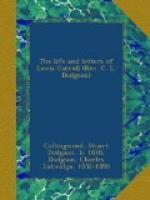Niemand.—Both
ways. He adds, directly
afterwards, “A line
has two different directions,” &c.
Minos.—So
your definition needs a postscript.... But
there is yet another difficulty.
How far from a point is the
“next” point?
Niemand.—At
an infinitely small distance, of course.
You will find the matter fully
discussed in my work on the
Infinitesimal Calculus.
Minos.—A
most satisfactory answer for a teacher to
make to a pupil just beginning
Geometry!
In Act IV. Euclid reappears to Minos, “followed by the ghosts of Archimedes, Pythagoras, &c., who have come to see fair play.” Euclid thus sums up his case:—
“‘The cock doth craw, the day doth daw,’ and all respectable ghosts ought to be going home. Let me carry with me the hope that I have convinced you of the necessity of retaining my order and numbering, and my method of treating Straight Lines, Angles, Right Angles, and (most especially) Parallels. Leave me these untouched, and I shall look on with great contentment while other changes are made—while my proofs are abridged and improved—while alternative proofs are appended to mine—and while new Problems and Theorems are interpolated. In all these matters my Manual is capable of almost unlimited improvement.”
In Appendices I. and II. Mr. Dodgson quotes the opinions of two eminent mathematical teachers, Mr. Todhunter and Professor De Morgan, in support of his argument.
Before leaving this subject I should like to refer to a very novel use of Mr. Dodgson’s book—its employment in a school. Mr. G. Hopkins, Mathematical Master in the High School at Manchester, U.S., and himself the author of a “Manual of Plane Geometry,” has so employed it in a class of boys aged from fourteen or fifteen upwards. He first called their attention to some of the more prominent difficulties relating to the question of Parallels, put a copy of Euclid in their hands, and let them see his treatment of them, and after some discussion placed before them Mr. Dodgson’s “Euclid and His Modern Rivals” and “New Theory of Parallels.”
Perhaps it is the fact that American boys are sharper than English, but at any rate the youngsters are reported to have read the two books with an earnestness and a persistency that were as gratifying to their instructor as they were complimentary to Mr. Dodgson.
In June of the same year an entry in the Diary refers to a proposal in Convocation to allow the University Club to have a cricket-ground in the Parks. This had been proposed in 1867, and then rejected. Mr. Dodgson sent round to the Common Rooms copies of a poem on “The Deserted Parks,” which had been published by Messrs. Parker in 1867, and which was afterwards included in “Notes by an Oxford Chiel.” I quote the first few lines:—




